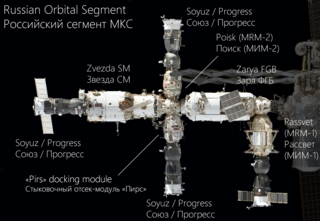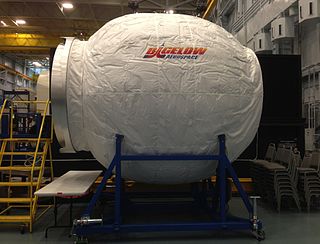Related Research Articles

The International Space Station (ISS) is a modular space station in low Earth orbit. The ISS programme is a multi-national collaborative project between five participating space agencies: NASA, Roscosmos (Russia), JAXA (Japan), ESA (Europe), and CSA (Canada). The ownership and use of the space station is established by intergovernmental treaties and agreements.

The Cupola is an ESA-built observatory module of the International Space Station (ISS). Its name derives from the Italian word cupola, which means "dome". Its seven windows are used to conduct experiments, dockings and observations of Earth. It was launched aboard Space Shuttle mission STS-130 on 8 February 2010 and attached to the Tranquility module. With the Cupola attached, ISS assembly reached 85 percent completion. The Cupola's central window has a diameter of 80 cm (31 in).

TransHab was a concept pursued by NASA in the 1990s to develop the technology for expandable habitats inflated by air in space. Specifically, TransHab was intended as a replacement for the already existing rigid International Space Station crew Habitation Module. When deflated, inflatable modules provide an 'easier to launch' compact form. When fully inflated, TransHab would expand to 8.2 meters in diameter.

Harmony, also known as Node 2, is the "utility hub" of the International Space Station. It connects the laboratory modules of the United States, Europe and Japan, as well as providing electrical power and electronic data. Sleeping cabins for four of the crew are housed here.

The Habitation Module for the International Space Station was intended to be the Station's main living quarters designed with galley, toilet, shower, sleep stations and medical facilities. About the size of a bus, the module was canceled after its pressurized hull was complete. If named and sent into space, the Habitation Module would have been berthed to Tranquility.

Tranquility, also known as Node 3, is a module of the International Space Station (ISS). It contains environmental control systems, life support systems, a toilet, exercise equipment, and an observation cupola.

Nicholas James MacDonald Patrick, Ph.D., is a British-American engineer and a former NASA astronaut. His flight on the 2006 Discovery STS-116 mission made him the fourth person born in the United Kingdom to go into space.

STS-130 was a NASA Space Shuttle mission to the International Space Station (ISS). Space ShuttleEndeavour's primary payloads were the Tranquility module and the Cupola, a robotic control station with six windows around its sides and another in the center, providing a 360-degree view around the station. Endeavour launched at 04:14 EST on 8 February 2010 and landed at 22:22 EST on 21 February 2010 on runway 15 at the Kennedy Space Center's Shuttle Landing Facility.

Reaction Engines Limited (REL) is a British aerospace manufacturer based in Oxfordshire, England.

Inflatable habitats or expandable habitats are pressurized structures capable of supporting life in outer space whose internal volume increases after launch. They have frequently been proposed for use in space applications to provide a greater volume of living space for a given mass.

The process of assembling the International Space Station (ISS) has been under way since the 1990s. Zarya, the first ISS module, was launched by a Proton rocket on 20 November 1998. The STS-88 Space Shuttle mission followed two weeks after Zarya was launched, bringing Unity, the first of three node modules, and connecting it to Zarya. This bare 2-module core of the ISS remained uncrewed for the next one and a half years, until in July 2000 the Russian module Zvezda was launched by a Proton rocket, allowing a maximum crew of two astronauts or cosmonauts to be on the ISS permanently.

The Russian Orbital Segment (ROS) is the name given to the components of the International Space Station (ISS) constructed in Russia and operated by the Russian Federal Space Agency (Roscosmos). The ROS handles Guidance, Navigation, and Control for the entire Station.

The Treadmill with Vibration Isolation Stabilization System, commonly abbreviated as TVIS, is a treadmill for use on board the International Space Station and is designed to allow astronauts to run without vibrating delicate microgravity science experiments in adjacent labs. International Space Station treadmills, not necessarily described here, have included the original treadmill, the original TVIS, the БД-2, the Combined Operational Load Bearing External Resistance Treadmill (COLBERT), and the Treadmill 2. Some share a name, some a design, some a function, some use different (passive) vibration-suppression systems, some it is unclear how they differ.

The Orbital Piloted Assembly and Experiment Complex was a 2009–2017 Russian proposed third-generation modular space station for Low Earth orbit.

The US Orbital Segment (USOS) is the name given to the components of the International Space Station (ISS) constructed and operated by the United States National Aeronautics and Space Administration (NASA), European Space Agency (ESA), Canadian Space Agency (CSA) and Japan Aerospace Exploration Agency (JAXA). The segment currently consists of eleven pressurized components and various external elements, all of which were delivered by the Space Shuttle.

The International Space Station Environmental Control and Life Support System (ECLSS) is a life support system that provides or controls atmospheric pressure, fire detection and suppression, oxygen levels, waste management and water supply. The highest priority for the ECLSS is the ISS atmosphere, but the system also collects, processes, and stores waste and water produced and used by the crew—a process that recycles fluid from the sink, shower, toilet, and condensation from the air. The Elektron system aboard Zvezda and a similar system in Destiny generate oxygen aboard the station. The crew has a backup option in the form of bottled oxygen and Solid Fuel Oxygen Generation (SFOG) canisters. Carbon dioxide is removed from the air by the Russian Vozdukh system in Zvezda, one Carbon Dioxide Removal Assembly (CDRA) located in the U.S. Lab module, and one CDRA in the U.S. Node 3 module. Other by-products of human metabolism, such as methane from the intestines and ammonia from sweat, are removed by activated charcoal filters or by the Trace Contaminant Control System (TCCS).

The Deep Space Habitat (DSH) is a series of concepts by NASA that would be used to support crewed exploration missions to the Moon, asteroids, and eventually Mars.

The European contribution to the International Space Station comes from 10 members of the European Space Agency (ESA) and amounts to an 8% share in the programme. It consists of a number of modules in the US segment, ATV supply ships, launchers, software and €8 billion.

The Bigelow Expandable Activity Module (BEAM) is an experimental expandable space station module developed by Bigelow Aerospace, under contract to NASA, for testing as a temporary module on the International Space Station (ISS) from 2016 to at least 2020. It arrived at the ISS on April 10, 2016, was berthed to the station on April 16, and was expanded and pressurized on May 28, 2016.

SpaceX CRS-21, also known as SpaceX-21, is a Commercial Resupply Service mission to the International Space Station planned to be launched on 30 October 2020. The mission is contracted by NASA and will be flown by SpaceX using a Cargo Dragon. This will be the first flight for SpaceX under NASA's CRS-2 contract awarded in January 2016.
References
- ↑ Hsu, Jeremy. "Space Station Modules Proposed by UK Scientists". Space.com. Retrieved 18 January 2008.
- ↑ Hempsell, Mark. "Habitation Extension Module". Bris.ac.uk. Archived from the original on 12 January 2008. Retrieved 20 January 2008.

